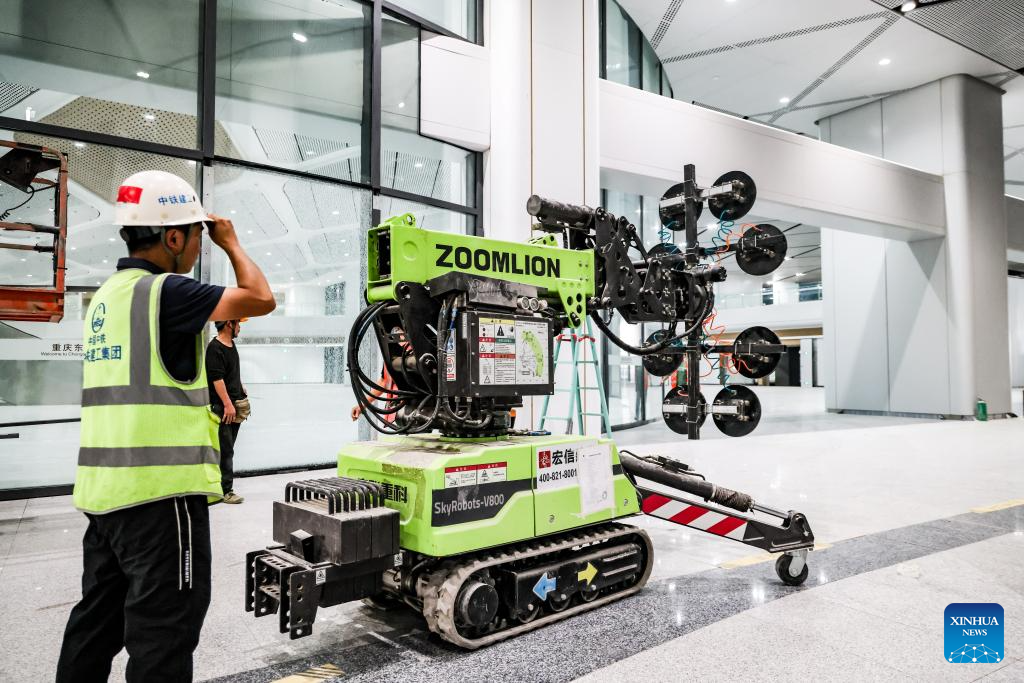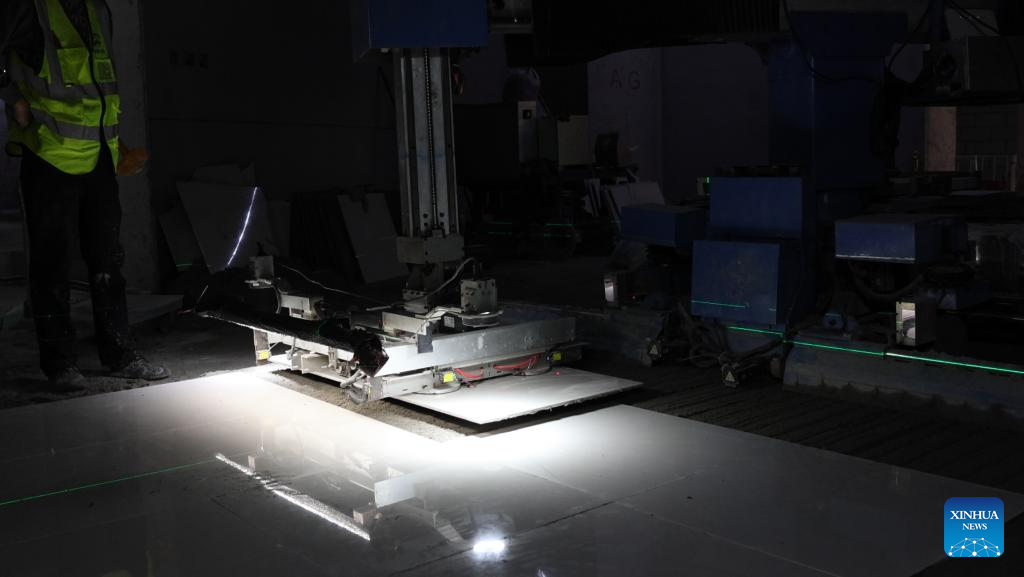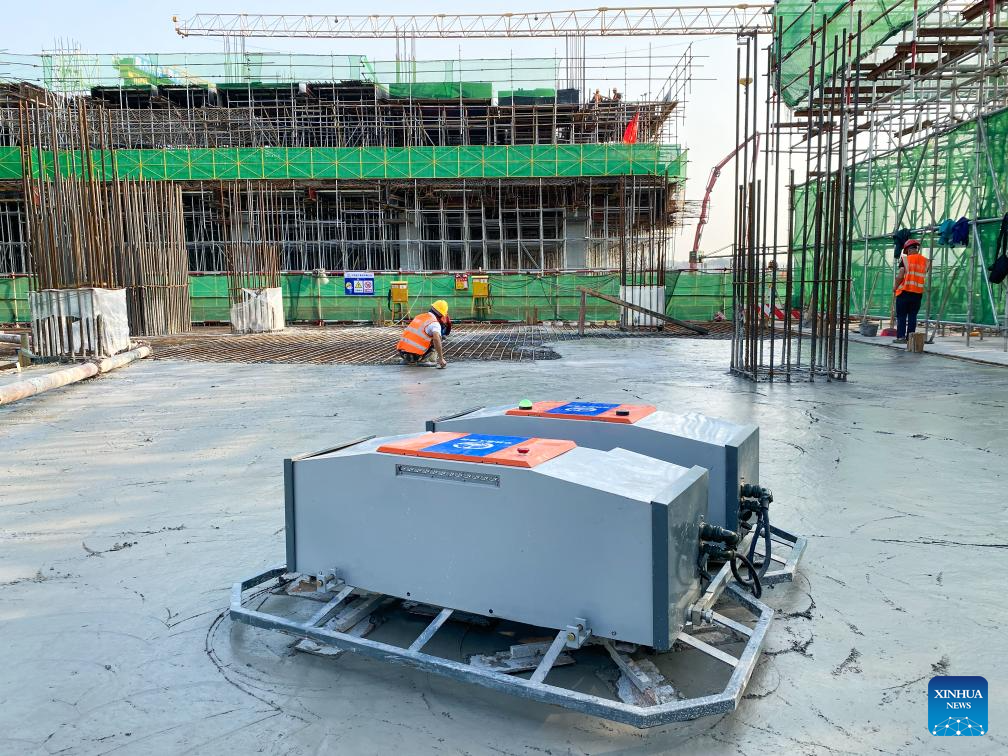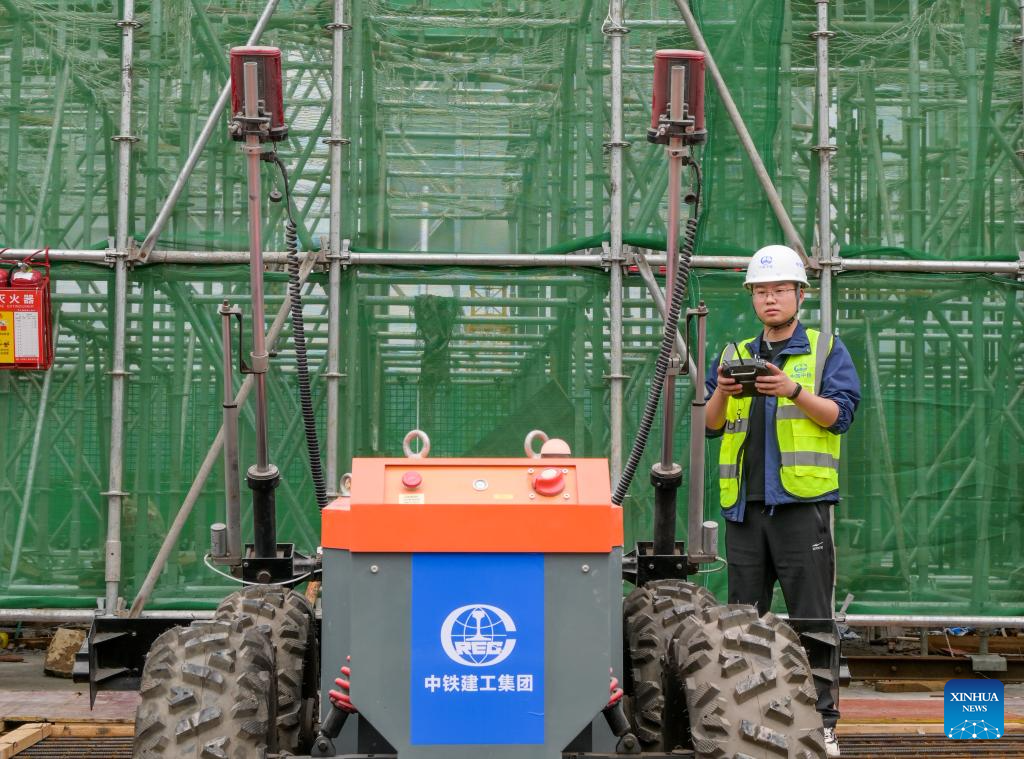A robot revolution in building the largest railway station in west China
Source: Xinhua
Editor: huaxia
2025-07-03 14:10:30

A technician with China Railway Construction Engineering Group debugs a glass curtain wall installation robot at the construction site of Chongqing East Railway Station, in southwest China's Chongqing, on June 21, 2025. As the new section of the Chongqing-Xiamen high-speed railway, from Chongqing to Qianjiang, officially opened a week ago, the key hub along this route, Chongqing East Railway Station, was also put into operation. From obtaining the design blueprints in May 2022 to its official inauguration, it has taken 38 months to complete what is now the largest high-speed rail station in west China. Behind this monumental construction project are a group of unsung heroes -- robots. (China Railway Construction Engineering Group/Handout via Xinhua)
by Xinhua writers Yi Ling and Zhao Jiale
CHONGQING, July 3 (Xinhua) -- As the new section of the Chongqing-Xiamen high-speed railway, from Chongqing to Qianjiang, officially opened a week ago, the key hub along this route, Chongqing East Railway Station, was also put into operation.
From obtaining the design blueprints in May 2022 to its official inauguration, it has taken 38 months to complete what is now the largest high-speed rail station in west China. Behind this monumental construction project are a group of unsung heroes -- robots.
According to Sun Haoran, a manager of the railway station project under China Railway Construction Engineering Group, the station serves as a pilot for the "integration of stations and cities" as part of the nation's efforts to strengthen transportation infrastructure.
Located in the Nan'an District of Chongqing, the station features 15 platforms and 29 tracks. The station building spans eight floors with a total construction area of 1.22 million square meters, equivalent to 170 standard football fields. Its roof covers approximately 120,000 square meters and weighs 16,500 tonnes.
"The scale of the station's roof alone is colossal, making the construction difficult and posing high safety risks," Sun said.
Indeed, in this city where temperatures regularly hit 40 degrees Celsius during furnace-like summers, building a vast transportation hub on its rugged topography demands innovation.
Robots have conducted a quiet revolution, transforming conventional construction in extreme environments.
"Ground leveling in 40-degree heat used to mean workers often collapsing from heatstroke," said Huang Pinqing, a senior official with China Railway 11th Bureau Group Corporation Limited, who is in charge of the railway station project.
"Now, laser-guided bots did the job with millimeter precision at three times human speed, cutting labour costs by 40 percent."
"Meanwhile, in this mountain furnace in summer, steel never sweats," he added.
Huang proudly introduced his "robot army."
Four-wheel laser screed machines, equipped with LiDAR sensors, AI algorithms, and 5G connectivity, replaced manual concrete smoothing. While workers remotely monitor them from shaded shelters, their precision reduces waste.
Patrol robots, undeterred by night or rain, became 24/7 sentinels. Using AI vision, they detect the absence of hard hats or misplaced vehicles within 100 meters during the day or 50 meters at night, slashing hazard identification time by 90 percent and quadrupling the quality inspection efficiency, he said.
Glass installation robots tackle 800-kilogram panels needed for soaring facades. Precision servo arms position the massive glass units with millimeter accuracy, accelerating installation threefold while reducing accident risks by 90 percent compared to manual hoisting by dozens of workers.
Omni-directional welding robots were used for joining overhead pipe installations. Capable of 0.1-millimeter accuracy swing control, they sealed an 800-millimeter diameter steel pipe joint in two hours -- one-third the time required manually -- ensuring consistent quality on high-altitude tasks.
"Robots free our teams from the worst heat exposure," Huang said. "They aren't gimmicks but essential partners."
Data from China Railway 11th Bureau Group Corporation Limited confirmed that robotics tripled average work efficiency and nearly halved labour costs.
In addition, safety incidents dropped by 90 percent, despite Chongqing's challenging topography, where summer heatwaves now regularly test construction limits, including record-breaking temperatures in 2022 and 2024, forcing traditional sites to suspend daytime work.
"This is how technology serves people -- building faster, safer, and smarter, even in Chongqing's furnace," said Huang.
This mountainous metropolis is also accelerating the power of automation to reshape infrastructure development and beyond.
According to the Chongqing Municipal Economy and Information Technology Commission, in recent years, Chongqing has drafted action plans to boost robot application and cultivate future industries, empowering the development of the robotics industry from a top-level institutional perspective.
By 2024, the city's robotics output exceeded 60,000 units, with the total industrial chain output value surpassing 37 billion yuan (about 5.17 billion U.S. dollars).
Meanwhile, the city is creating an internationally competitive intelligent equipment industrial cluster.
Currently, Chongqing has gathered over 300 key robotics enterprises, and hosts 31 research and development platforms, such as the Chongqing Institute of Green and Intelligent Technology under the Chinese Academy of Sciences and a national robotics testing center.
This has led to the establishment of a comprehensive ecosystem encompassing research and development, manufacturing, testing, system integration, component supply, talent training and application services. ■

This photo taken on July 29, 2024 shows a tile-laying robot working at the construction site of Chongqing East Railway Station in southwest China's Chongqing. As the new section of the Chongqing-Xiamen high-speed railway, from Chongqing to Qianjiang, officially opened a week ago, the key hub along this route, Chongqing East Railway Station, was also put into operation.
From obtaining the design blueprints in May 2022 to its official inauguration, it has taken 38 months to complete what is now the largest high-speed rail station in west China. Behind this monumental construction project are a group of unsung heroes -- robots. (China Railway Construction Engineering Group/Handout via Xinhua)

This photo taken on April 27, 2023 shows a four-head screed robot working at the construction site of Chongqing East Railway Station in southwest China's Chongqing. As the new section of the Chongqing-Xiamen high-speed railway, from Chongqing to Qianjiang, officially opened a week ago, the key hub along this route, Chongqing East Railway Station, was also put into operation.
From obtaining the design blueprints in May 2022 to its official inauguration, it has taken 38 months to complete what is now the largest high-speed rail station in west China. Behind this monumental construction project are a group of unsung heroes -- robots. (China Railway Construction Engineering Group/Handout via Xinhua)

This photo taken on April 27, 2023 shows a technician with China Railway Construction Engineering Group operates a four-wheel screed machine at the construction site of Chongqing East Railway Station in southwest China's Chongqing. As the new section of the Chongqing-Xiamen high-speed railway, from Chongqing to Qianjiang, officially opened a week ago, the key hub along this route, Chongqing East Railway Station, was also put into operation.
From obtaining the design blueprints in May 2022 to its official inauguration, it has taken 38 months to complete what is now the largest high-speed rail station in west China. Behind this monumental construction project are a group of unsung heroes -- robots. (China Railway Construction Engineering Group/Handout via Xinhua)



